Mark Amery – 16 March, 2014
Rather than a sculpture of many different sides placed before you, an array of handsomely made props are laid out together, to be puzzled over and then understood belatedly through wall text or film voiceover. The artist creates conceptual halls of mirrors. These mirrors are in effect highly polished, revealing the carefully constructed detail of things in relation to each other.
Simon Starling’s works are highly refined, highly tuned, almost highly strung. This survey exhibition of six projects (all but one premiered in the last eight years) presents this quite brilliant artist’s rich, tightly packed conceptual works as being as concerned with the beautiful crafting of things as the practice of any high-end craftsperson. He is a builder of strong conceptual structures, of mechanisms that tell stories.
The survey is a partnership between Monash University of Art, IMA Brisbane and City Gallery. Another early gift from the former IMA director and new CGW curator Robert Leonard, it is smartly laid out in Wellington. It’s an impressive show, notwithstanding that the 2013 work that gives the exhibition its title feels slighter than the rest, and that there are no New Zealand commissions to complement the Australian. And yet, for all the works’ layered brilliance, a line from Peggy Lee continues to nag at me: Is that all there is, to a fire?
How things are made and how things are viewed are central interests. Each work explores absurdly new ways in which a narrative and other structures might be ingeniously constructed, edited or put together. Each also pays tribute to acts of fine craft and construction and their transformative potential, from mask-making and balsa wood plane making to film editing. Employing film, installation and texts, different found objects, events and stories are spliced together through experimenting with the agency of different technologies. With this survey Starling’s interest in exploring process is neatly underlined by the selected work all dealing with workshops or studios of one kind or another.
Often there’s a globetrotting interweaving of modernism’s art and design disciplines and histories. With a sharp intellect and wit (dry but never dull), Starling explores how objects might be viewed or placed in reflection with each other in relation to their place in the world through various forms of communication.
Rather than a sculpture of many different sides placed before you, an array of handsomely made props are laid out together, to be puzzled over and then understood belatedly through wall text or film voiceover. The artist creates conceptual halls of mirrors. These mirrors are in effect highly polished, revealing the carefully constructed detail of things in relation to each other. Appropriately, the exhibition title In Speculum is taken from a recent body of work employing speculum, the alloy used to create all-metal mirrors for telescopes. Equally however the meaning of speculum as a tool used for viewing a body’s cavities feels strangely apt. Starling’s exacting attention to detail might even have you mulling on anal-retentivity.
In Wilhelm Noack oHG a film projector runs its celluloid in long loops through reels on the end of the spokes of a helix-like spiral steel staircase, almost reaching from roof to floor. This fantastic Bauhaus-like sculptural mechanism was designed specifically for the length of the loop of film being projected in the space. The film is a collage of black and white moving image of the workshops of Wilihelm Noack, a long standing metal fabrication business in Berlin which worked on both Bauhaus and Third Reich projects, and various still visual material relating to Noack history.
To a loud soundtrack of the clangs and bangs of heavy metal machinery and manufacture, the camera spins and shunts in echo of these processes, and various trolleys and machinery in the workshops are used as a substitute for camera dollies. In this way the factory itself supports the filmmaking. The factory we also learn made the film projector itself, its design inspired by staircases the firm has built. The whole work thus follows a compelling, complex spiraling circular logic: it is a camera made for a film that employs and is about the place that made the camera.
Or try Three White Desks for an exercise in the circuitous. It was inspired by the story of Australian writer Patrick White having to get remade a desk, made for him originally by painter Francis Bacon, from a photograph after he had sold it. Alongside this original photograph, paintings of the original desk and other visual ephemera there are three copies of the ‘White’ desk mounted on their exhibition packing crates in the gallery (the use of the crates is a conceptual move that didn’t quite pull off).
Commissioned by Starling from three different furniture-makers around the world, each desk is a further generation on from the last based on a photograph, and each visually looks significantly different. The first is commissioned from the original photograph. The second two were commissioned from low grade digital images, as specified by the artist. The third desk (a copy of a copy of a copy of the original from a photograph) isn’t even white. This we learn only when you read the wall text. The work neatly expresses the troubled contemporary relationship between digital technology, history and the fine art of making. I am in the habit of reading wall texts last lest they cloud my interpretation. With Starling’s work they should arguably be read first, given the artist has a strong authorial hand in them.
The kernel of Starling’s works is often from an object or event/s associated with the location of the gallery or museum they were commissioned by (take for local comparison the recent work for Sarjeant Gallery Whanganui by Ann Shelton, or even more pertinently fellow globetrotter Michael Stevenson). For the film Project for a Masquerade (Hiroshima) at the Hiroshima City Museum of Contemporary art, it’s a small Henry Moore sculpture called Atom Piece. Resembling a mushroom cloud and human head, a larger earlier version is to be found at the University of Chicago, commissioned outside the laboratory where the first nuclear chain reaction was created. Moore said - disingenuously our narrator suggests - that it was inspired by an elephant skull.
The Moore sculpture is but one character in an eccentric cast of 20th century historical and fictional figures (or figurines) introduced to us as performers in a reinterpretation of an ancient Japanese Noh play about duplicity and double agency. As in Three White Desks Starling explores the concept of the stand-in.
In the film we watch a master mask maker creating these characters’ wooden masks, including the Sean Connery James Bond, Goldfinger‘s Odd Job, art critic and spy Anthony Blunt and Colonel Sanders, a statue of whom in Japan (I think I have this right) is mistaken for a Japanese God.
The work is a thing of wonder. A captivating, masterful maze. Delivered in documentary style it extends across media our concepts of what a story, a play, a sculpture, a film or a visual artwork might be.
Yet back to Peggy Lee. For all the work’s sharp wit and smarts, it doesn’t really change or affect me, it just fascinates for a while. Folding disparate things together artfully, the work feels empty and ungrounded at its centre. The narrative voice is apolitical and impassive. It neatly reflects the global, hyper-linked decentralized cultural network we all share, but it remains just this, a complex reflection. Following our contemporary love of technology, Starling seems more interested in viewing mechanisms than the stories and people they depict.
Starling delights in circular ways of thinking. Circles run continually through his work. Yet in this survey these felt like loops that don’t really take us anywhere, they just keep going round and around.
Given how well it reflects our contemporary condition, perhaps we get what we deserve. And surely we didn’t ask anymore of Cezanne when he broke up the picture plane. But I’m reminded of those novelists who are brilliant at creating fascinating, complex structures, but less at actual stories that move you (as a side note I heard Eleanor Catton speak of this during Festival Writers Weeks: to not be one of those writers, but to provide both a complex structure and a moving narrative.)
Perhaps a wider survey would have afforded a more generous view. I found Starling’s film Autoxylopyrocycloboros at Adam Art Gallery two years ago far more compelling in its expression of the circular nature of the way our lives and the world operates.
To add to Peggy Lee, I was reminded of some words of Mary Shelley in Frankenstein: “Invention, it must be humbly admitted, does not consist in creating out of void, but out of chaos; the materials must, in the first place, be afforded: it can give form to dark, shapeless substances, but cannot bring into being the substance itself.”
In Spectrum is full of beautiful invention but I still find myself asking where the substance and effect is.
Mark Amery
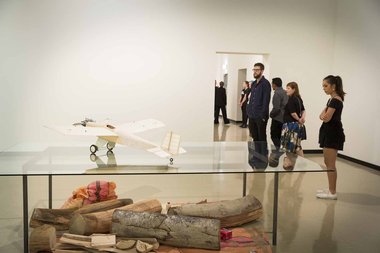
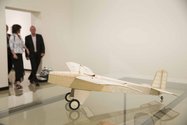
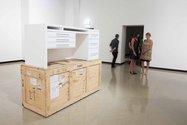
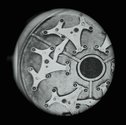
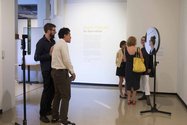
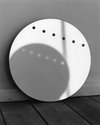
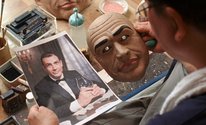
 Two Rooms presents a program of residencies and projects
Two Rooms presents a program of residencies and projects Advertising in this column
Advertising in this column



This Discussion has 0 comments.
Comment
Participate
Register to Participate.
Sign in
Sign in to an existing account.